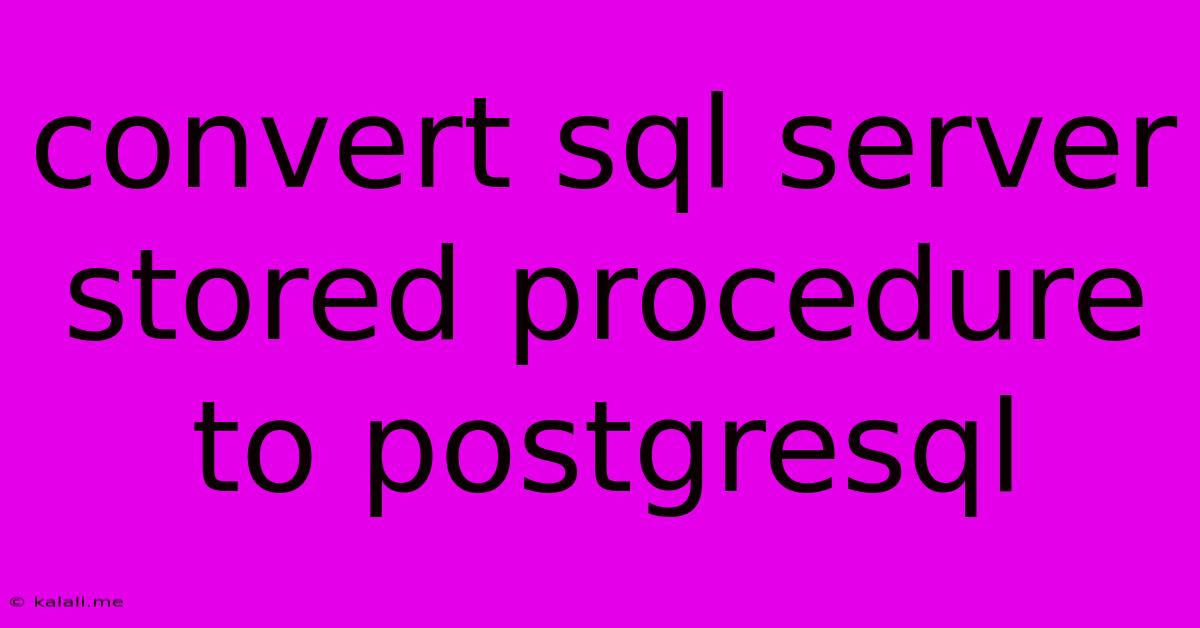Convert Sql Server Stored Procedure To Postgresql
Kalali
May 25, 2025 · 3 min read

Table of Contents
Converting SQL Server Stored Procedures to PostgreSQL: A Comprehensive Guide
Migrating a database system is a complex undertaking, and converting stored procedures from SQL Server to PostgreSQL requires careful planning and execution. This comprehensive guide will walk you through the process, highlighting key differences and providing practical examples to help you successfully migrate your stored procedures. This conversion involves more than simple syntax changes; it requires understanding the underlying database differences and adapting your code accordingly.
Understanding the Key Differences:
Before diving into the conversion process, it's crucial to understand the fundamental differences between SQL Server and PostgreSQL. These differences impact how stored procedures are written and executed:
- Data Types: SQL Server and PostgreSQL have different data type systems. You'll need to map SQL Server data types to their PostgreSQL equivalents. For example,
VARCHAR(255)in SQL Server might becomeVARCHAR(255)in PostgreSQL, but careful consideration is needed for types likeUNIQUEIDENTIFIER(consider usingUUIDin PostgreSQL). - Functions and System Procedures: Many built-in functions and system procedures differ between the two systems. You'll need to find PostgreSQL equivalents for any SQL Server-specific functions used in your stored procedures.
- Syntax: While SQL is largely standard, there are subtle syntax differences. For instance, the way you handle
NULLvalues,CASEstatements, and date/time functions might need adjustments. - Output Parameters: Handling output parameters may differ slightly. PostgreSQL often uses
OUTparameters orRETURNS TABLEfor more complex scenarios, whereas SQL Server usesOUTPUTparameters more extensively. - Transactions: While both support transactions, the syntax for managing them can vary.
Step-by-Step Conversion Process:
-
Analyze and Document: Begin by thoroughly analyzing your SQL Server stored procedures. Document their functionality, input parameters, output parameters, and any dependencies on other database objects. This step is crucial for a smooth migration.
-
Data Type Mapping: Create a mapping table to translate SQL Server data types to their PostgreSQL counterparts. Pay close attention to nuanced differences, especially concerning precision and scale for numeric types and character length limitations.
-
Function and Procedure Replacement: Identify and replace any SQL Server-specific functions or system procedures with their PostgreSQL equivalents. This often involves searching for suitable PostgreSQL functions with similar functionality. Utilize PostgreSQL's extensive documentation to locate appropriate alternatives.
-
Syntax Conversion: Systematically convert the SQL Server syntax to PostgreSQL syntax. This involves careful attention to detail, checking for inconsistencies in
CASEstatements,NULLhandling, date/time formatting, and string functions. Tools like pgAdmin can assist in syntax highlighting and error detection. -
Testing and Validation: Thoroughly test the converted stored procedures with various input scenarios to ensure they produce the expected results. Compare the output against the original SQL Server stored procedures to verify accuracy. Pay attention to edge cases and error handling.
-
Refactoring and Optimization: Once the stored procedures are functioning correctly, review the code for areas of improvement. PostgreSQL might offer more efficient ways to accomplish certain tasks. Consider using indexes appropriately for improved query performance.
Example Conversion:
Let's say you have a simple SQL Server stored procedure:
-- SQL Server Stored Procedure
CREATE PROCEDURE GetCustomerName (@CustomerID INT)
AS
BEGIN
SELECT CustomerName FROM Customers WHERE CustomerID = @CustomerID;
END;
The equivalent PostgreSQL function would be:
-- PostgreSQL Function
CREATE OR REPLACE FUNCTION GetCustomerName(CustomerID INT)
RETURNS TEXT AS $
BEGIN
RETURN (SELECT CustomerName FROM Customers WHERE CustomerID = CustomerID);
END;
$ LANGUAGE plpgsql;
Tools and Resources:
While there isn't a single tool that automatically converts SQL Server stored procedures to PostgreSQL, several tools can assist:
- pgAdmin: A powerful PostgreSQL administration tool with a built-in SQL editor and debugger.
- SQL Developer (Oracle): While primarily for Oracle, its SQL editor can help with syntax checking and code formatting.
Conclusion:
Converting SQL Server stored procedures to PostgreSQL requires a methodical approach, careful attention to detail, and a thorough understanding of both database systems. By following the steps outlined in this guide and leveraging available tools, you can successfully migrate your stored procedures and ensure the continued functionality of your application. Remember that thorough testing is paramount to ensure data integrity and application stability after the migration.
Latest Posts
Latest Posts
-
How Many Apples In 3 Lb Bag
Jul 05, 2025
-
What Is Half A Quarter Of 400
Jul 05, 2025
-
How Do You Make A Vegetable Necklace
Jul 05, 2025
-
How Many 750ml Are In 1 75 Liters
Jul 05, 2025
-
How Many Grams Is In Half An Ounce
Jul 05, 2025
Related Post
Thank you for visiting our website which covers about Convert Sql Server Stored Procedure To Postgresql . We hope the information provided has been useful to you. Feel free to contact us if you have any questions or need further assistance. See you next time and don't miss to bookmark.